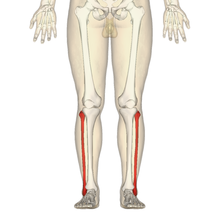Fibula
The fibula ( lat. Fibula ( f .) "Tacking needle", "clasp") is adjacent to the shinbone ( tibia ) on which it rests laterally on the outside, one of the two bones of the lower leg . The fibula is the thinner of the two bones and a typical long bone .
Fibula in mammals
head
The thickened upper end, the head of the fibula ( caput fibulae ), tapers upwards into a point ( apex capitis ). It is connected to the shinbone at the central circumference by a three-sided, inwardly curved (concave) joint surface ( facies articularis capitis fibulae ), but has no connection to the thighbone ( femur ). In ruminants , the fibula head is fused with the lateral tibial gnar ( condylus lateralis tibiae ), so the articulated connection is broken.
shaft
The long and, compared to the shin, very thin calf community ( corpus fibulae ) lies on the side of the shin. It does not show very pronounced edges ( Margo medialis , Margo lateralis and Margo interosseus ) that divide the body into three surfaces ( Facies medialis , Facies lateralis and Facies posterior ). In ruminants, the shaft is completely regressed, in horses it only extends to the middle of the lower leg. The gap between the tibia and calf community ( Spatium interosseum cruris ) is spanned by strong connective tissue fibers ( Membrana interossea cruris ) through a band ( syndesmosis ).
Lower end
The thickened lower end of the fibula forms the outer malleolus ( lateral malleolus ). A furrow ( sulcus malleolaris lateralis ) for the tendons of the musculus peroneus runs over its outside . On its inside there is a joint surface ( Facies articularis malleoli ) for connection with the ankle bone ( talus ) and thus for the formation of the ankle joint and behind it a pit ( Fossa malleoli lateralis ), to which ligaments attach. In ruminants, an independent bone ( os malleolare ) is formed as a remnant of the largely rudimentary fibula . In horses, the lower end of the fibula is completely fused with the shin bone, so that in this type of animal the fibula is only formed as an independent bone in the upper half of the lower leg.
function
The fibula has no functional influence on the knee joint , but with its lower end forms part of the upper ankle joint . From there it conducts the forces acting on the leg via the upper shin-fibula joint ( articulatio tibiofibularis proximalis ) and the ligament between the two bones ( membrana interossea cruris ) to the shinbone and thus to the thighbone ( femur ).
Diseases
A fracture of the upper fibula ( fibular fracture , Pott fracture ) is rare. It is treated surgically by means of osteosynthesis using metal plates and screws or intramedullary nailing . In the case of ankle fractures , the lateral malleolus ( lateral malleolus ) belonging to the fibula is often also affected.
Fibular aplasia, also known as fibular hemimelia , is a malformation in which the fibula is not developed. Usually only one extremity is affected.
